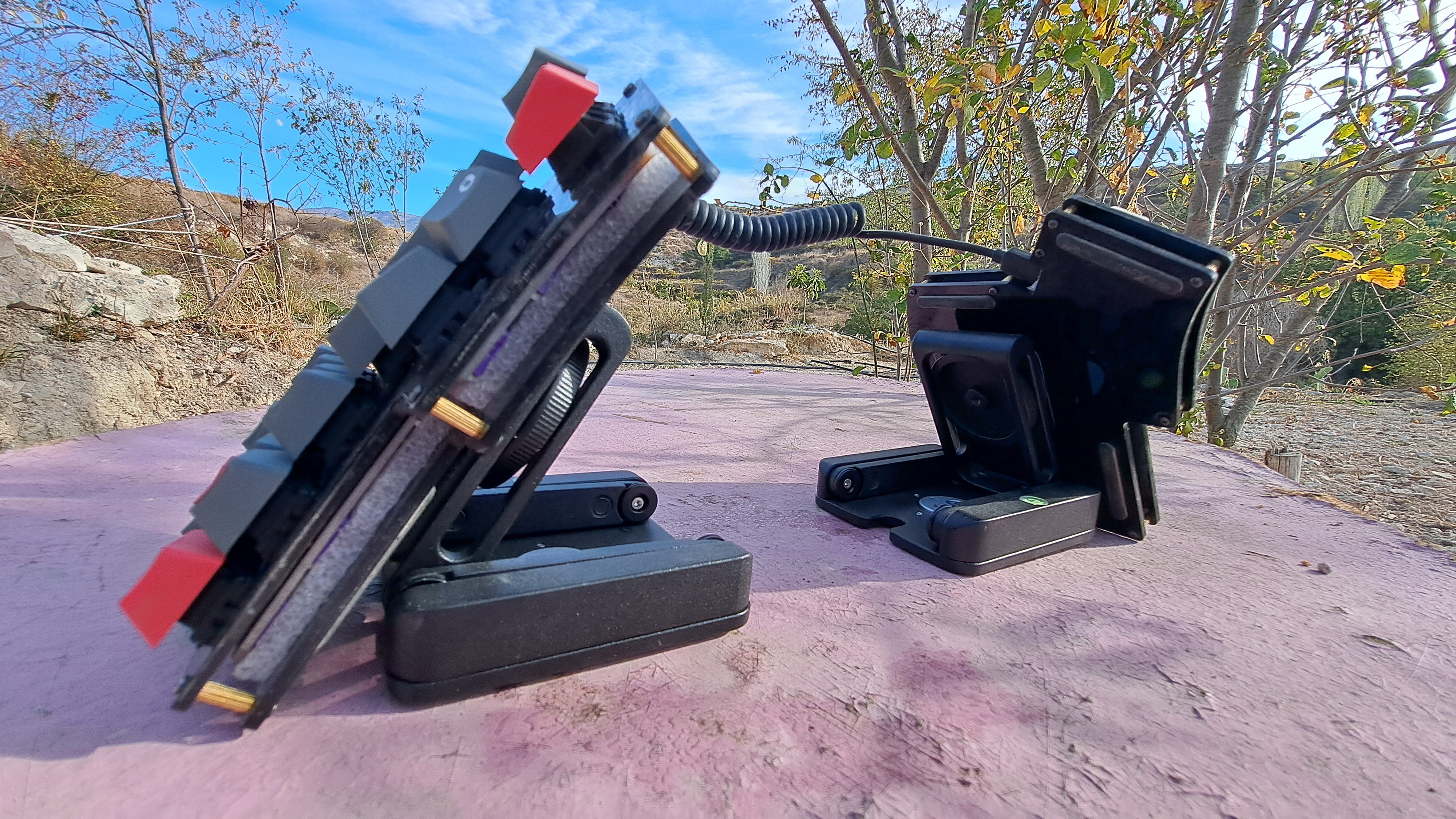Tenting my split mechanical keyboard with magnets
I have a new tenting setup for my split mechanical keyboard that works with magnetism. Behold:
Thanks to Arialdo Martini, a fellow keyboard and Emacs enthusiast, for gifting me these stands. You can read more on Reddit: https://www.reddit.com/r/olkb/comments/1lk02oo/how_i_tilt_my_split_crab_broom/.
Works great and fits my needs
I have been using this configuration full-time for almost a week now. My first impression is highly positive. There is no wobble whatsoever where the board connects to the stands, while the base is sturdy. I am typing at a decent speed with a fairly heavy touch and do not notice any instability. The steep angle does not seem to affect the reliability of the switches: they are firmly attached to their sockets and have not popped off.
The tent is comfortable to type on both while standing and sitting. I am mostly standing when I work on the computer, though I did experiment for a couple of hours with a sitting position to have a more informed opinion. My initial concern was that the steep angle would force me to compromise on how I arrange my desk, but it so far seems to not be an issue. I can use the keyboard however I need to.
The other concern I had was about the effective weight of the switches. The initial touches felt a bit heavier than usual, which could be the result of the gravitational pull being different. Or I simply needed to warm up a bit and get back in the flow of typing at an angle. The switches have since felt the same as usual, which is great because I enjoy them a lot.
A neat way to increase comfort
Apart from its utility, I also appreciate how elegant of a tenting solution this is. The stand has an adjustable arm which we use to control the angle we are typing at. At its top we connect a circular magnet by screwing it in place. Then, at the bottom plate of each half of the keyboard we attach a thin metallic sheet that is sticky on one side and magnetic on the other. Once the sticky side is firmly glued to the board, we bring the two magnets in contact and—bang!—we are ready for action. It took me less than ten minutes to piece everything together and I did not need any specialised tools to make it happen.
I have always appreciated the option of tenting. It is yet another way to increase typing comfort and promote good posture. Though tenting can only deliver on its promise if it is stable and sufficiently flexible to allow for experimentation. If stability is not there and the typing angles cannot be tweaked reliably to match the user’s evolving needs, then tenting is an untenable compromise: better keep the keyboard flat on the desk.
Tenting has to be done right
That was the issue I had with my original tenting solution, which involved regular nuts and bolts. My keyboard’s case takes an optional middle layer between the top and bottom parts that enclose the circuit board. This middle layer shields the PCB from small particles and also provides openings for a makeshift tenting arrangement. By adding bolts to its inner sides, I managed to elevate the two pieces by about 4 centimetres. The typing angle was not as sharp as I would like, but it still offered some relief from prolonged pronation.
- The first problem was that I was constrained by the available length of the bolts. Those I found in the local hardware store were not as long as they needed to be to support a greater degree angle.
- The second problem was the instability of the bolts, owning to the small surface area of their base, its poor grip on my desk, even with a deskpad, and their lack of heft.
The bolt-supported tent was fine in the beginning because I was still adjusting to the split and columnar key layout. At the time I was also in pain, which made my key presses relatively weak. The otherwise flimsy setup was stable enough. Though once I got accustomed to the keyboard and the pain subsided, I could no longer type with momentum and keep the board in place. So I went back to placing it flat on the desk, much to my disappointment.
Typing with confidence
Right now I am typing comfortably without holding back on each key press. The stands have not moved at all. I also removed the middle layer, to gain a few extra degrees of tenting. Plus, it looks cooler this way.
What remains to be determined is whether my established preferences for cap profile (Cherry) and switch type (heavy linear) will stay the same. I am not keen on introducing further changes, though I might run some experiments in the future. Time will tell and I shall report on my progress, should anything change.
Details of what is shown in the picture:
- Iris keyboard, by Keebio, revision 8. Thanks to “Andreas” for this gift.
- The magnetic stands, courtesy of Arialdo Martini.
- Keychron Cherry profile Dolch Red keycaps. Thanks to the person who bought me these and who prefers to remain anonymous.
- Cherry MX2A Black Silent switches. Thanks to me for a fine purchase during last year’s sales.
- A second-hand coffee table I found on the side of the road. It is worn down but gets the job done.
- The bushlands around my hut in the mountains of Cyprus!
And here is my complete QMK firmware configuration for the Iris: https://github.com/protesilaos/qmk/tree/master/keyboards/keebio/iris/keymaps/prot.
Finally, remember that no matter how much we optimise the keyboard and desk, we still are not made to sit all day. Regular breaks are essential to our longevity.
